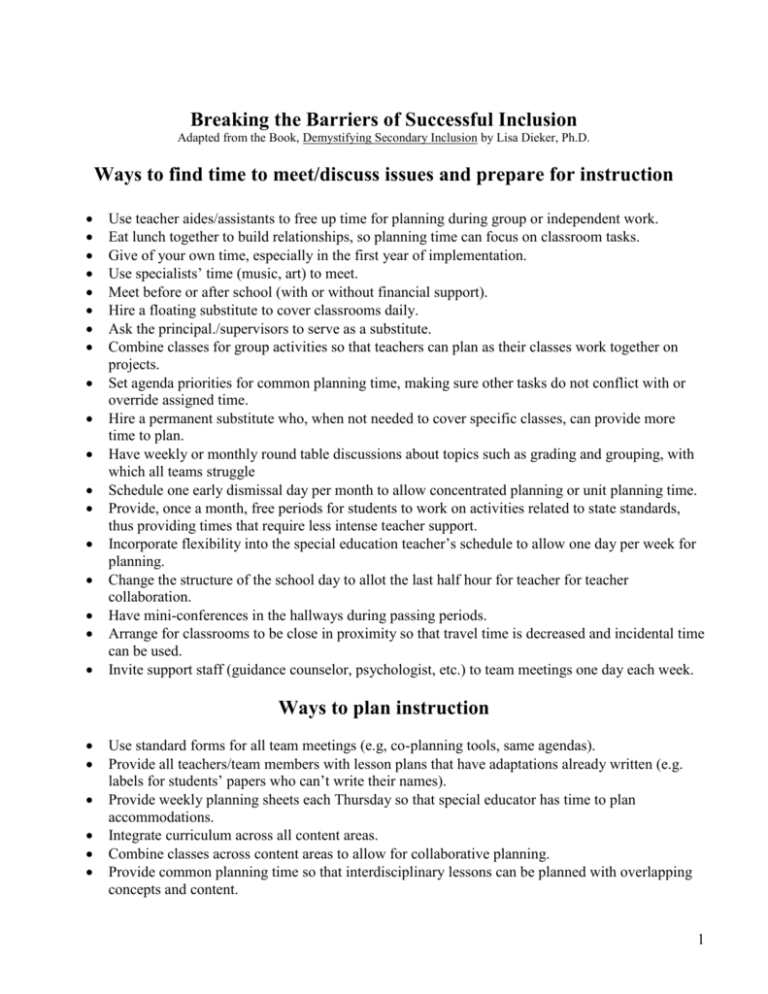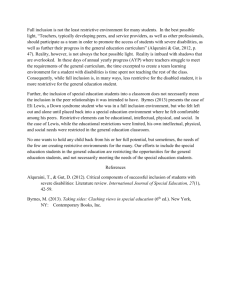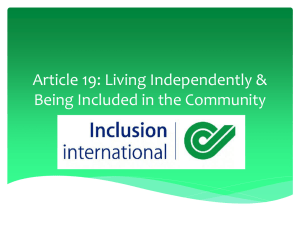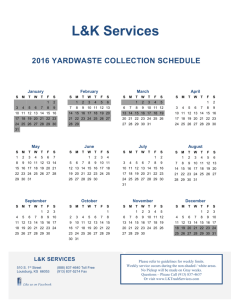Ways to find time to meet/discuss issues and prepare for instruction
advertisement

Breaking the Barriers of Successful Inclusion Adapted from the Book, Demystifying Secondary Inclusion by Lisa Dieker, Ph.D. Ways to find time to meet/discuss issues and prepare for instruction Use teacher aides/assistants to free up time for planning during group or independent work. Eat lunch together to build relationships, so planning time can focus on classroom tasks. Give of your own time, especially in the first year of implementation. Use specialists’ time (music, art) to meet. Meet before or after school (with or without financial support). Hire a floating substitute to cover classrooms daily. Ask the principal./supervisors to serve as a substitute. Combine classes for group activities so that teachers can plan as their classes work together on projects. Set agenda priorities for common planning time, making sure other tasks do not conflict with or override assigned time. Hire a permanent substitute who, when not needed to cover specific classes, can provide more time to plan. Have weekly or monthly round table discussions about topics such as grading and grouping, with which all teams struggle Schedule one early dismissal day per month to allow concentrated planning or unit planning time. Provide, once a month, free periods for students to work on activities related to state standards, thus providing times that require less intense teacher support. Incorporate flexibility into the special education teacher’s schedule to allow one day per week for planning. Change the structure of the school day to allot the last half hour for teacher for teacher collaboration. Have mini-conferences in the hallways during passing periods. Arrange for classrooms to be close in proximity so that travel time is decreased and incidental time can be used. Invite support staff (guidance counselor, psychologist, etc.) to team meetings one day each week. Ways to plan instruction Use standard forms for all team meetings (e.g, co-planning tools, same agendas). Provide all teachers/team members with lesson plans that have adaptations already written (e.g. labels for students’ papers who can’t write their names). Provide weekly planning sheets each Thursday so that special educator has time to plan accommodations. Integrate curriculum across all content areas. Combine classes across content areas to allow for collaborative planning. Provide common planning time so that interdisciplinary lessons can be planned with overlapping concepts and content. 1 Encourage teams to talk daily. Create a teacher assistance team to deal with more problematic issues. Focus on high expectations, not labels such as “Special Education”. Ways to schedule students and teachers for inclusion Be as flexible as possible. Schedule students with special needs first. Schedule team meetings as a priority. Group students with disabilities into one section, but choose a high achieving instead of a low achieving section. Use paraprofessionals to assist in covering general education settings. Schedule students with disabilities individually. Ensure teacher input into master schedule. Allow inclusive classes to schedule first, scheduling other classes around these. Change the schedule each quarter, if necessary. Try for coinciding planning time when possible (grade level, title teacher, special educator). Meet by teams everyday, even if just for five minutes before school. Plan an entire unit the spring before or at the beginning of the year so time during the week is more productive. Schedule classes with a balance of ability levels (don’t group all nonreaders into one class). Review and change schedules as needed. Alternate days on which the special educator works in various rooms. Be flexible with student labels; use a cross-categorical teaching model. Enable students who might fall through the cracks to get special education support in inclusive classes. Use Title teacher/speech teacher to support students in co-teaching classes. Avoid placing students somewhere for one reason and depriving them of something else. Ways to increase communication within the school Send newsletters to all teachers (daily or weekly) related to students’ needs. Provide staff with one-half day in-service time before the start of each quarter. Provide weekly inclusive memos. Provide binders that contain work samples of students’ strengths and needs. Schedule monthly portfolio review meetings. Provide a color-coded page of accommodations for each grade. Organize a teacher advisory board to oversee inclusion. Have an inclusion potluck/lunch meeting monthly. Designate time in staff meetings for teachers to collaborate. Provide assignment sheets that are used across classes to communicate the amount and type of daily homework each teacher is giving. 2 Conduct monthly articulation meetings focused on students who are doing well as well as those who are struggling. Suggest teachers make once-weekly phone calls to each other to talk about life outside of school. Write progress reports as a team. Hire a permanent substitute teacher to provide more time to communicate. Provide common planning time when creating the master schedule. Create an inclusion guidelines/philosophy book. Hold voluntary teacher input meetings related to inclusion. Provide collaborative teachers with a flexible schedule. Have a mailbox system to communicate concerns, maybe in the form of e-mail or a blog. Have a “tip of the day” inclusion chalkboard in lounge. Hold monthly faculty or grade level meetings. Ways to increase communication with parents Hold team/parent conferences, accommodating times to parents’ availability. Schedule parent/teacher conferences once a month, such as office hours. Provide all parents with a weekly memo/newsletter that celebrates all students. Report accomplishments to parents as well as difficulties – a strength-based approach. Send home written notes daily, or ask students to write their own daily summaries that the teacher initials. Require teachers to make two parent contacts each week. Create good news notes that students can fill out and the teacher signs to send home. Develop a “Friday Big Stuff Sheet” that lists events and tests for the following week. Have open houses and ask a local business to provide food. Ensure parents, as well as students when appropriate, can attend IEP meetings. Encourage all parents to volunteer one hour a month in classrooms. Create a homework hotline or a website listing assignments and examples of how to do the work. Ways to increase communication with other staff (psychologists, administrators, superintendents, etc.) Hold weekly team meetings that bring all support staff together to talk about target students. Provide psychologist with one day a week to meet with staff across teams. Ensure administrative support by inviting them to attend a team meeting at last once a month. Ensure all support staff submit brief reports for monthly memos. Designate one person per team to communicate with outside team members. Ways to modify the curriculum Schedule time for teachers to meet. Have last years’ teachers meet with new teachers. 3 Provide a list of possible testing adaptations. Use behavior journals to document concerns and identity success across teachers. Create a behavior plan across classroom and resource teachers. Share the general education curriculum and the IEP with all teachers. Schedule inclusion students in homeroom and study hall for re-teaching and review. Collaborate on all planning. Provide different textbooks with the same content at an easier reading level. Provide textbooks on tape or get material from www.bookshare.org. Share adapted assignments/tests. Ways to adapt instruction Have students highlight their notes and text. Type up a copy of the classroom notes. Shorten assignments. Ask students to do comparable work at lower skill level. Vary questioning techniques. Use co-teaching to make accommodations, maybe even just one day a week. Have a special educator or paraprofessional read the test or provide it on tape recorder. Give tests in small groups. Change print/font size. Provide one step, oral directions. Provide books on tape. Keep students informed of their progress. Construct assignment goals for individual abilities. Provide project choices that allow students to use their strengths. Develop accommodation sheets for teachers. Provide a note taker. Allow for alternative response modes. Ways to deal with students with difficult behavior Use a common disciplinary system for all classes, with consistency across all teachers: a Positive Behavioral Support Model. Focus school-wide on rewarding good behavior instead of acknowledging bad behavior. Bring student issues to teacher assistance teams for additional support. Hire an itinerant teacher to support students with behavior disorders across teachers. Use peer mediators. Provide a time-out area/cooling off spot that is not punitive, and that students can choose to use as needed. Provide behavior charts to students to assist them in working on their own behavior. Provide support before/after class related to behavioral issues. Allow students to walk the halls or take a break in a positive way before they explode. Provide green slips/gold slips for random acts of kindness and draw for prizes each month. 4 Focus on academic and behavioral issues during planning time. Have behavior journals that go across classrooms. Create a behavior plan with classroom and resource teachers. Involve all school personnel, parents, and the student. Ensure teams talk every day about students with serious behavioral concerns. Provide incentives for positive behavior. Establish a policy that all behavior problems are addressed as they occur. Ways to prepare students for transitions Plan for the transition together with student and all teachers/staff. Communicate with present and previous teachers. Consult with previous teacher weekly and then taper off gradually. Teach students self-advocacy skills. Identify all resources that are available to support the transition. Provide a peer to help with the transition. Create a peer tutoring program. Offer home-base groups to help students develop a sense of belonging. Keep students informed. Have student visit with teaching assistant for short periods of time before the transition occurs. Talk about transition as a natural occurrence. Provide support from the social worker as needed. Discuss transition issues weekly throughout the spring in team meetings. Ways to increase peer acceptance Expect students to be accepting. Handle students with disabilities in the same manner as others (don’t try to protect too much). Talk in all classes about how everyone learns differently. Use peer helpers, planned and unplanned. Have a social skills curriculum for all students. Ensure that developing tolerance begins in kindergarten. Have a specialist on certain disabilities come in to talk with students. Have a disability awareness week. Encourage students to read about all areas of disability. Allow peers to be accepted through natural occurrence. Have all students listed together on class lists; do not separate out included students. Ensure the participation of all students in school-wide activities (assemblies, behavior programs, trips). Use general education students as classroom aides. Encourage all students to be in extra curricular activities. Adapted from the Book, Demystifying Secondary Inclusion by Lisa Dieker, Ph.D. 5






